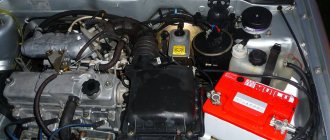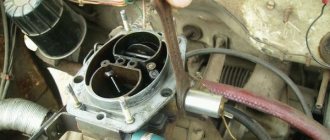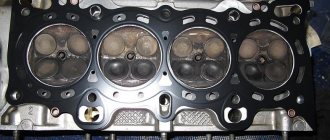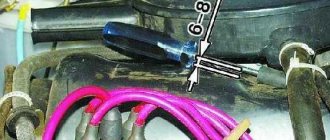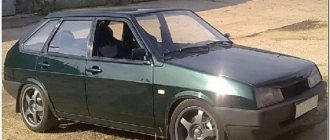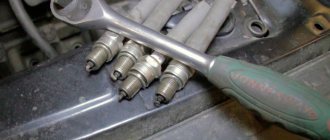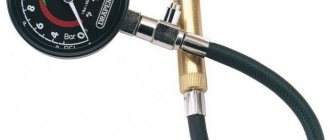Why the VAZ 2109 does not start - searching for the reason
The first step is to check the fuel, spark and air.
I would advise you to first check the air supply (compression and valve timing), you can also start by checking the ignition system.
The marks on the pulleys may match, but the compression may fail a little, for example: on one cylinder there is 10 atm, on the second 9.5 atm, on the third 7 atm, and on the fourth 8 atm, this can only be corrected by engine repair. Of course, it is worth getting serious about repairing the engine, but for now we need to put it off, since we will need to start the car. Having such compression, the engine will work and even not bad, but at idle it will be under pressure.
VAZ 2109 will not start - a method for finding reasons
VAZ 2109 does not start: start checking with a spark, Hall sensor and the condition of the spark plugs. Then measure the compression, check the timing marks, fuel pump and starter. More details
Checking the power system
Next, we begin to delve into the power system. You will need to make sure that the carburetor is at the correct level, the pump is supplying fuel properly, and the idle air valve is working without failure. Therefore, everything is in order with the fuel supply. Also, do not forget to check the spark plugs; after a couple of attempts to start the engine, they will probably flood.
Checking the ignition system
Since the previous failure options were not confirmed, then the problem needs to be looked for in the ignition system. To carry out a routine check, simple instruments are useful; they can be bought without any problems at any auto store. But first you need to understand the structure and operation of the ignition.
And so, in our case, the VAZ 2109 has a contactless ignition system. This system includes:
- reel,
- distributor,
- switch,
- Hall Sensor.
The coil is connected to the battery with one terminal, and the second to the output transistor of the switch. The switch opens the output transistor when the signal drops to zero. At this moment, a high voltage current of approximately 25 kV appears in the secondary winding of the coil, and a current of more than 300 V appears in the primary winding. As a result, a high voltage voltage appears on the spark plugs, resulting in a spark appearing on the plugs.
But for a discharge to occur, the coil must be charged. Before the control pulse from the Hall sensor, the switch predicts when it needs to be shorted to ground in order to charge it.
Moreover, he does this in such a way that the charging time of the coil remains approximately unchanged. Otherwise, the coil will overcharge. To do this, the switch calculates the required period of the pulses that come from the Hall sensor. In other words, everything depends on the engine speed, the higher the speed, earlier the commutator begins to close the coil, but the time of the closed state will not change.
Now you can start testing. First of all, you need to check the spark on the candles - you can use a special spark gap for this. There is no result.
This means the hall sensor or switch may be to blame, or ground or power to the switch. In order not to guess for a long time, we will use AZ-1.
AZ-1 is an emergency ignition; it can be used in the rain or when driving through puddles. In other words, we can call it a substitute for a hall sensor.
The MD-1 sensor is an instant diagnostic, useful for checking the functionality of the ignition coil, hall sensor and ignition switch.
First of all, we used MD-1. This sensor is connected instead of the switch, as soon as it is hooked up, you need to turn on the ignition, do not start it:
- If the “P” LED lights up, this means that the ignition relay and ignition switch are working properly.
- LED “K” is on - the primary winding of the ignition coil is not damaged.
- turn on the starter: if the LED “D” blinks, it means the Hall sensor is in working condition.
VAZ-2109 does not start - what to do?
In general, diagnosing malfunctions of the controller (computer) and control system sensors, as well as the VAZ-2109 injector itself, is not much different from similar work for other cars. But due to the peculiarities of the “nine” control system, experienced owners of this car recommend the following solutions.
Most often, the injection “nine” does not start in winter. In this case, it is advisable to warm up and even recharge the battery - perhaps due to loss of capacity due to low temperature, it is not able to spin the engine shaft well.
Another “folk” method that helps is supplying air to the engine filter through a hairdryer. At the same time, heated air will flow into the cylinders. Many people claim that the VAZ starts right away.
Another possible reason: as a result of prolonged unsuccessful attempts to start, the spark plugs were filled with gasoline. In this case, it is recommended to try to start the car with the gas pedal pressed all the way to the floor - the spark plugs should dry out and the car will start. If this does not help, then unscrew the spark plugs and check for the presence of a spark. If it is not there, then either the spark plugs or the ignition system are faulty.
Operating principle
The quantity and quality of the fuel mixture in the injector is controlled electronically. Sensors are located throughout the engine unit, the signals from which are intercepted from the microprocessor and converted to the fuel supply system. The same processor controls the mixture ignition system in the combustion chamber
.
If any sensor malfunctions, the output control pulse ceases to correspond to the parameters of the normal functioning of the engine, and it refuses to work, in other words, it does not start.
Electronic engine control unit
The engine control unit is responsible for the operation of almost the entire car. In this part, hundreds of processes are calculated, all readings from sensors installed on the car are processed. Many people call the ECU a “computer” and it’s impossible to disagree with this. The unit, receiving readings from the sensors, processes them and controls the engine, adjusting the supply of fuel and air to the combustion chamber.
Location
The engine control unit on the VAZ 2109 is located under the glove compartment at the feet of the front passenger. You can see it by looking under the panel; the block is closed with a special plastic cover.
Signs of malfunction:
Problems with the operation of the sensor are most often associated with damage to the microcircuit, for example, burnout of a track or damage to one of the radio components, due to which one of the cylinders may fail, etc. It is quite difficult to judge the failure of the ECU based on its symptoms, since they are all similar to the failure of one of the sensors, so the malfunction of the unit can only be determined by diagnosing, disassembling, or replacing it with a known good one.
On-board power system
Problems with starting the injector on the 2109 especially manifest themselves in winter, on cars that while away the nights in cold garages and “in an open field.” The morning for them begins with a long warm-up. However, after being in the cold
, the battery loses all its performance and requires recharging. That is why most motorists take the battery with them to a warm apartment in winter.
Particularly advanced car enthusiasts place a hairdryer under the air filter, trying to supply warm air to the cylinders and give the engine “artificial respiration” - they say it can help.
Candles
Spark plugs are the next most likely cause of a failure to start the engine. After repeated attempts to start, they simply drown in fuel, as drivers say: the spark plugs are flooded.
Experienced car enthusiasts recommend that in such a situation, press the gas pedal to the floor and turn on the ignition
, after such manipulation the spark plugs dry out and begin to produce a normal spark.
Injectors
Due to the “high-quality” domestic fuel, injectors tend to become clogged with slag more often than is provided for by the standards for their uninterrupted operation. Checking them is as simple as checking for the presence of a spark in the candles. If you just attach the spark plugs to the engine body and turn the starter to see the presence or absence of a spark, then you can check the injector using the same principle.
Other reasons
If everything is normal with the supply and ignition system, the next culprit in the VAZ 21093 injector does not start is the timing belt. In frosty weather, when the lubricant has not yet warmed up, the shaft turns with difficulty, the belt slips and all synchronous operation of the engine is disrupted. The valve cycle is broken
.
This version can be confirmed or rejected by checking with the mark on the timing belt. If it matches, most likely the wire has broken off the sensor located on the shaft and the spark plug appears at the wrong time. However, if the sensor is in place, then the last reason remains and it is not only impossible to eliminate it on your own, but also impossible to diagnose - the electronics unit has failed. In this case, the tow rope is taken out and the car is sent to the service station.
In the article “VAZ 2109 will not start,” we examined in detail the reasons why the VAZ 2108, VAZ 2109, VAZ 21099 carburetor does not start . However, injection VAZ 2109 have their own characteristics, so this article is intended to help the owners of a VAZ 2108 2109 21099 injector when their iron horse stops starting. The differences in troubleshooting for carburetor and injection engines are very significant. Thus, the owner of a carburetor VAZ 2108, VAZ 2109, VAZ 21099 can, with his eyes closed, determine why his car does not start. However, if you transfer him to an injection VAZ 2108, VAZ 2109, VAZ 21099, which does not start, then the person will not know what to do. It’s understandable: an electric fuel pump, an ECU, a bunch of sensors, injectors, an ignition module. Without knowing what and in what order to look, a situation where an injection engine does not start can quite frighten the car owner. Here, as in diagnosing any malfunction, a clear, well-thought-out sequence of actions to identify the malfunction is important. So let's start, if the engine VAZ 2108 2109 21099 injector does not start, then the old rule applies here: “Either there is nothing to burn, or there is nothing to ignite.” That is, either there is no spark, or the combustible mixture does not enter the engine cylinders. 1) Check if there is a spark. To do this, unscrew the spark plug from the cylinder, press it against the ground and turn the starter. If the spark jumps at the spark plug, then the problem is in the fuel supply system. However, we must remember that if the unscrewed spark plug is wet and there is a spark, be sure to check the timing belt marks.
Elimination methods
The main reason that the engine may not gain speed is the formation of an air-fuel mixture. So, the engine does not receive the correct ratio of gasoline and air, which affects the operation of the power unit and the burning mixture does not sufficiently spin the crankshaft, which drives the wheels.
Let's look at the basic diagnostic operations and repair methods.
Bad "fuel"
First of all, it is necessary to understand what quality of gasoline is poured into the system and whether it is possible for it to burn correctly and completely. This will determine not only whether the crankshaft can spin up, but also whether the power system is clogged.
Typically, the main indicator of gasoline quality is the condition of the fuel filter. If it clogs too often, it is recommended to change the fuel supplier. To fix the problem, it is necessary to clean the entire fuel supply system, from the fuel tank to the injectors. Also, it is worth diagnosing and cleaning the piston group, where most likely the pistons already have carbon deposits.
Ignition system malfunctions
More than once, the reason that the engine does not pick up speed well has been the ignition unit. Failure of spark plugs or high-voltage wires is a direct sign of problems of various types. Carrying out diagnostic operations is quite simple. The spark plugs are unscrewed and inspected for cracks and carbon deposits.
If there is no visible damage, then it is worth checking the performance on a special spark plug stand. If inoperative spark plugs are found, it is recommended to change them, first setting the gap.
High-voltage wires are removed from the vehicle and checked using a tester. If the resistance is more or less than 5 ohms, then this is the reason.
It is worth considering the fact that high-voltage wires must be replaced in sets.
Formation of the air-fuel mixture
To form an air-fuel mixture, two things are needed - fuel and air. In this context, a blockage in one of the systems will lead to the combustible mixture being formed incorrectly, which will affect the operation of the power unit.
As for the clogging of the injection system, it is often the injectors. Usually, to cure a malfunction, it is enough to simply clean the elements, but not always. It happens that the injectors are too clogged and the elements will need to be replaced. Many car enthusiasts do not know that this part is dismountable and it is enough to change the nozzles, which have a much lower price.
Clogging of the air supply system occurs when the unit is not maintained in a timely manner. The first place to look is the air filter. In this context, not enough air enters the engine cylinders, which leads to incomplete combustion of gasoline, kinetics that are not enough to put enough pressure on the pistons and spin the crankshaft.
The next element that is recommended to be checked is the throttle valve. A clogged or jammed element can lead to the effect described above. You can clean the unit yourself using a regular carburetor cleaner.
Piston group
More than once, the cause of engine malfunction was carbon deposits in the piston group. It can be eliminated using special automotive chemicals or folk methods. But, as practice shows, this does not last long, and the engine has to be overhauled. Also, it is worth noting that carbon deposits will be not only on the piston group, but also on the valves.
A combination of factors can become the underlying cause of a malfunction and the advisability of a major overhaul.
Electronics
The only element that is almost impossible to diagnose at home is electronics. So, a malfunction of one of the sensors or malfunctions in the electronic engine control unit will lead to improper operation of the engine. To diagnose and fix the problem, you need to contact a specialist.
Often, many engine owners turn to a tuner to carry out chip tuning of the VAZ 2109 engine. This will eliminate defects in the factory firmware, as well as reduce consumption or increase the power of the power unit.
